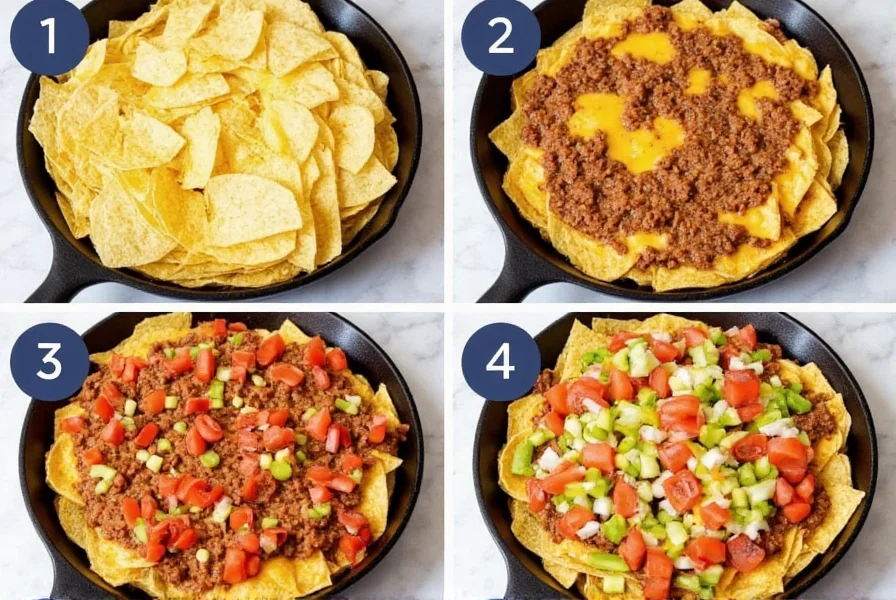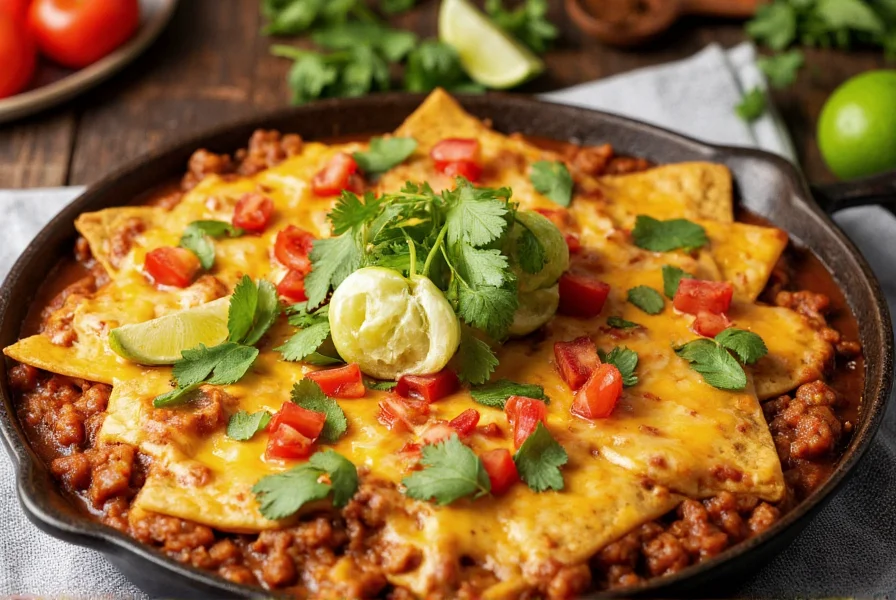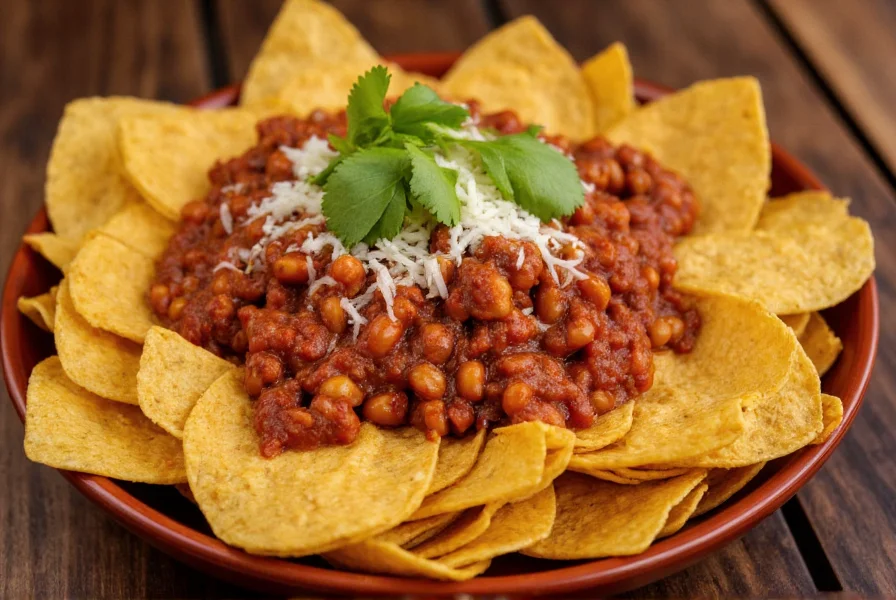Chili nachos have evolved from simple street food to a crowd-pleasing favorite at sports bars, family dinners, and game nights. Unlike traditional nachos that feature just cheese and chips, chili nachos incorporate a robust meat chili component that transforms this snack into a substantial meal. Understanding the proper technique ensures your homemade version avoids the common pitfalls of soggy chips or bland flavors.
Essential Ingredients for Authentic Chili Nachos
The foundation of exceptional chili nachos starts with quality components. While regional variations exist, these core elements create the perfect balance of textures and flavors:
| Category | Essential Ingredients | Optional Enhancements |
|---|---|---|
| Base | Sturdy restaurant-style tortilla chips | Homemade baked chips |
| Chili | Meat chili with beans or bean-free | Smoked paprika, chipotle peppers |
| Cheese | Sharp cheddar or queso blanco | Oaxaca cheese, pepper jack |
| Toppings | Guacamole, sour cream, jalapeños | Pico de gallo, cilantro, pickled red onions |
Selecting the right tortilla chips makes or breaks your chili nachos experience. Opt for thick, restaurant-style chips that can withstand the weight of chili without becoming soggy. Many home cooks make the mistake of using standard thin chips that disintegrate under the chili's moisture. For the chili component, a well-seasoned meat chili with either kidney beans or pinto beans provides the necessary heartiness. The cheese selection should melt beautifully while maintaining flavor—sharp cheddar offers classic appeal while queso blanco creates that authentic Mexican restaurant experience.

Step-by-Step Preparation Guide
Creating perfect chili nachos requires strategic layering to maintain chip integrity while ensuring even distribution of flavors. Follow this professional technique for restaurant-quality results at home:
- Prep components separately - Warm your chili (but don't boil), shred cheese finely, and prepare all toppings
- First chip layer - Arrange a single layer of chips on a baking sheet or oven-safe dish
- Chili application - Spoon warm chili evenly over chips, leaving small gaps between portions
- Cheese coverage - Sprinkle shredded cheese directly over chili portions (not the bare chips)
- Broil briefly - Melt cheese under broiler for 2-3 minutes until bubbly but not browned
- Repeat layering - Add additional chip, chili, and cheese layers as needed
- Final toppings - Add cold toppings like guacamole and sour cream after baking
This layering method prevents the common issue of soggy nachos by allowing the cheese to create a protective barrier between the chili and upper chip layers. The professional technique for making chili nachos from scratch involves preparing components separately before assembly, rather than dumping everything together haphazardly.
Regional Variations and Creative Twists
While traditional chili nachos follow the basic formula, regional preferences have created distinctive styles worth exploring:
- Texas-style - Features a bean-free chili with coarse-ground beef and generous cumin
- California version - Incorporates avocado and fresh salsa as primary toppings
- Midwest interpretation - Often includes ground beef with kidney beans and yellow cheese
- Vegan adaptation - Uses plant-based chili and cashew cheese alternatives
For those seeking spicy chili nachos preparation with extra heat, consider adding pickled jalapeños between layers or mixing chipotle peppers into your chili base. The key to successful variations lies in maintaining the essential structural balance—crispy base, hearty chili layer, melted cheese barrier, and fresh toppings.
Serving Suggestions and Pairing Ideas
Chili nachos shine as both a standalone meal and part of a larger spread. Consider these pairing strategies for different occasions:
- Sports gatherings - Serve in individual portions with cold beer or micheladas
- Family dinners - Pair with Mexican rice and black beans for a complete meal
- Casual entertaining - Offer a nacho bar with multiple topping options
- Game day - Cut into wedges and serve with chilled margaritas
The ideal chili nachos serving suggestions depend on your audience and occasion. For larger groups, consider using a cast-iron skillet which keeps nachos warm longer and provides that authentic presentation. When serving as an appetizer, smaller portions with fewer layers work best, while main course portions benefit from additional chili and cheese layers.

Troubleshooting Common Issues
Even experienced cooks encounter challenges with chili nachos. Here's how to solve frequent problems:
- Soggy chips - Use thicker chips, warm chili slightly (not hot), and create cheese barriers between layers
- Uneven melting - Shred cheese finely and broil briefly rather than baking extensively
- Overpowering chili - Balance with cooling toppings like sour cream and avocado
- Difficulty cutting - Let nachos rest 2-3 minutes after baking before slicing
Mastering the authentic chili nachos ingredients ratio prevents these common issues. The ideal proportion maintains approximately 40% chips, 40% chili/cheese, and 20% toppings for optimal texture and flavor balance.
Frequently Asked Questions
What's the difference between nachos and chili nachos?
Traditional nachos feature just tortilla chips with melted cheese and possibly jalapeños, while chili nachos incorporate a hearty meat chili component as a primary layer. Chili nachos transform the snack into a complete meal with the addition of seasoned meat chili, making them substantially heartier than standard nachos.
Can I make chili nachos ahead of time?
While best served immediately, you can prep components ahead. Store chips in an airtight container, keep chili refrigerated, and shred cheese separately. Assemble and bake just before serving for optimal texture. Fully assembled nachos become soggy if prepared more than 15 minutes in advance.
What's the best cheese for chili nachos?
Sharp cheddar provides classic flavor and excellent melting properties, while queso blanco offers authentic Mexican restaurant quality with superior meltability. For enhanced flavor, try a blend of 60% sharp cheddar and 40% Monterey Jack. Avoid pre-shredded cheese which contains anti-caking agents that hinder smooth melting.
How do I prevent chili nachos from getting soggy?
Prevent sogginess by using thick restaurant-style chips, warming (not boiling) your chili, and creating cheese barriers between layers. The professional technique involves placing cheese directly on chili portions before adding the next chip layer, which creates a protective moisture barrier. Avoid overloading with wet ingredients and serve immediately after baking.
What are traditional toppings for chili nachos?
Traditional toppings include guacamole, sour cream, diced fresh tomatoes, sliced jalapeños, and chopped cilantro. Regional variations may add pickled red onions, pico de gallo, or black olives. The key is balancing creamy, fresh, and spicy elements to complement the hearty chili without overwhelming the dish.











 浙公网安备
33010002000092号
浙公网安备
33010002000092号 浙B2-20120091-4
浙B2-20120091-4